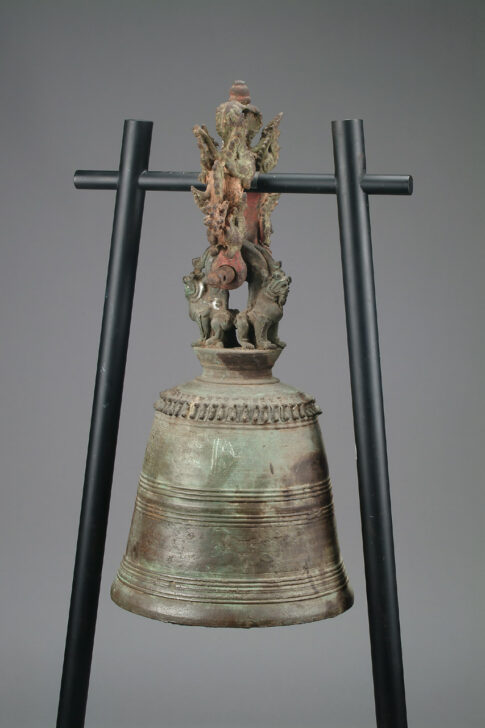Temple bell
Burmese; Artist Unknown

Description
While the history of percussive bells in the cultures of Asia dates back thousands of years, they became particularly important in Burma where every large temple has dozens of them in all sizes, most of which are donations from the pious. These bells do not have metal clappers and are rung by striking with a wooden stick. An account of Burmese life in the late nineteenth century has a chapter devoted to bells. It relates that
The bells are not intended to summon worshippers to their devotions…The use of bells is to direct attention to the fact of the lauds of the Buddha having been recited. The worshipper, when he has finished, goes to one of the bells and strikes it three times, to bring to the notice of the guardian spirits and the four worlds what he has been doing. There are always a number of deer’s antlers and billets of wood lying near the bell for this purpose.
From Shway Yoe, The Burman: His Life and Notions (London: Macmillan, 1896).
According to the inscription on this bell, dated June 4, 1907, it was donated to a village monastery by a family who, “keeping nibbana (nirvana) as the ultimate goal,” wanted to accumulate “good merit in this life and subsequent rebirths.” The acquisition of merit is the most common impetus behind donations to monasteries and temples in all Buddhist countries because it is a simple way for a layperson to assure a better life for him- or herself and his or her family in their next incarnation.
(Label for UMMA Buddhist Gallery Opening Rotation, March 2009)
Subject Matter:
While the history of percussive bells in the cultures of Asia dates back thousands of years, they became particularly important in Burma where every large temple has dozens of them in all sizes, most of which are donations from the pious.
According to the inscription on this bell, dated June 4th of 1907, it was donated to a village monastery by a family, who, “keeping nibbana (nirvana) as the ultimate goal,” wanted to accumulate “good merit in this life and subsequent rebirths.” The acquisition of merit is the most common impetus behind donations to monasteries and temples in all Buddhist countries as it is a simple way for a layperson to assure a better life for him- or herself and their family in their next incarnation.
Physical Description:
Wood base for a temple bell.
Usage Rights:
If you are interested in using an image for a publication, please visit https://umma.umich.edu/request-image/ for more information and to fill out the online Image Rights and Reproductions Request Form.